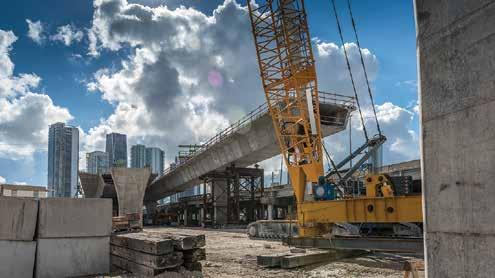
3 minute read
Infrastructure Investment and Jobs Act
BY PEDRO GRATEROL
While signed in 2021, The Infrastructure Investment and Jobs Act, more commonly known as the Bipartisan Infrastructure Bill, is one of the biggest investments in infrastructure in decades. This landmark legislation is set to be implemented over the next five years. While it is often overshadowed by its successor, the Inflation Reduction Act, it is critical to understand the different components of the IIJA in order to make sense of the changes that might be coming to our communities. Nevertheless, according to data from the think tank Third Way and Impact Research, only 24% know about it. The purpose of this article is to bring you all that you need to know about this important law.
Advertisement
Fundamentally, the IIJA is a list of largescale investments in multiple areas that will be implemented by government agencies from the Department of Transportation to the Department of Interior. The law represents an investment of approximately 1.2 trillion dollars, of which $550 billion are new investments. One of the most signifi- cant components of the bill is its provision to expand access to clean drinking water, eliminate lead service lines, and improve water infrastructure. The legislation invests $55 billion in this initiative. Another key aspect of the legislation is the $65 billion investment in broadband infrastructure deployment to ensure that all Americans have access to reliable high-speed internet. This aims to close the digital divide and make internet access more affordable for millions of Americans.
According to White House data, the Bipartisan Infrastructure Bill also aims to repair and rebuild the nation’s roads and bridges with a focus on climate change mitigation, resilience, equity, and safety. The legislation invests $110 billion in additional funding to repair roads and bridges and support major projects, making it the largest investment in repairing and reconstructing the nation’s bridges since the construction of the interstate highway system. Furthermore, the legislation includes $89.9 billion in funding for public transit over the next five years. The investment aims to expand public ración y reconstrucción de los puentes del país desde la construcción del sistema de autopistas interestatales. Además, la legislación incluye 89.9 mil millones de dólares en financiamiento para el transporte público en los próximos cinco años. La inversión tiene como objetivo expandir las opciones de transporte público en todos los estados, reemplazar miles de vehículos de transporte deficientes con vehículos de cero emisiones y mejorar la accesibilidad para los ancianos y las personas con discapacidades. Según el gobierno federal, esta iniciativa también ayudará a reducir las emisiones de gases de efecto invernadero del sector de transporte, que es actualmente la mayor fuente única de tales emisiones en los Estados Unidos. Sin embargo, la Associated Press informa que, aunque varios expertos han celebrado el proyecto de ley, también han mencionado que es solo un pequeño avance en la cantidad de inversión necesaria para abordar el estado deficiente del estado de la infraestructura de EE. UU. y su impacto ambiental. Los aeropuertos y puertos también son considerados en la legislación. Esto es para fortalecer las cadenas de suministro. La legislación invierte $17 mil millones en infraestructura portuaria y vías navegables y $25 mil millones en aeropuertos para abordar los retrasos en reparaciones y mantenimiento, reducir la congestión y las emisiones, y fomentar la electrificación y otras tecnologías de bajo carbono. Además, la legislación incluye una inversión de $66 mil millones en ferrocarril de pasajeros, la iniciativa tiene como objetivo eliminar el retraso en el mantenimiento de Amtrak, modernizar el Corredor Noreste y llevar un servicio ferroviario de clase mundial a áreas fuera del noreste y el Atlántico medio. A pesar de su tamaño, pocas personas saben sobre la aprobación de esta inversión en infraestructura nacional. Esto resalta la importancia de prestar atención a los eventos actuales y estar comprometidos cívicamente. Al mantenerse informados y comprometidos, las personas pueden entender los cambios que pueden venir a sus comunidades y participar activamente en dar forma al futuro de su país. El Proyecto de Ley de Infraestructura Bipartidista es solo un ejemplo de cómo mantenerse informado y comprometido puede marcar una diferencia en la dirección del país. transit options across every state, replace thousands of deficient transit vehicles with zero-emission vehicles, and improve accessibility for the elderly and people with disabilities. According to the White House, this initiative will also help reduce greenhouse gas emissions from the transportation sector, which is currently the largest single source of such emissions in the U.S. However, the Associated Press reports that, while multiple scholars have celebrated the bill, they also have mentioned that it is merely a dent on the amount of investment needed to address the deficient status of U.S infrastructure and its environmental impact.
Airports and Ports are also considered in the legislation. This is to strengthen supply chains. The legislation invests $17 billion in port infrastructure and waterways and $25 billion in airports to address repair and maintenance backlogs, reduce congestion and emissions, and drive electrification and other low-carbon technologies. Furthermore, the legislation includes a $66 billion investment in passenger rail, the initiative aims to eliminate the Amtrak maintenance backlog, modernize the Northeast Corridor, and bring world-class rail service to areas outside the northeast and mid-Atlantic.
Despite its size, few people know about the passing of this investment in national infrastructure. This highlights the importance of paying attention to current events and being civically engaged. By staying informed and engaged, individuals can understand the changes that may be coming to their communities and actively participate in shaping the future of their country. The Bipartisan Infrastructure Bill is just one example of how staying informed and engaged can make a difference in the direction of the country.








